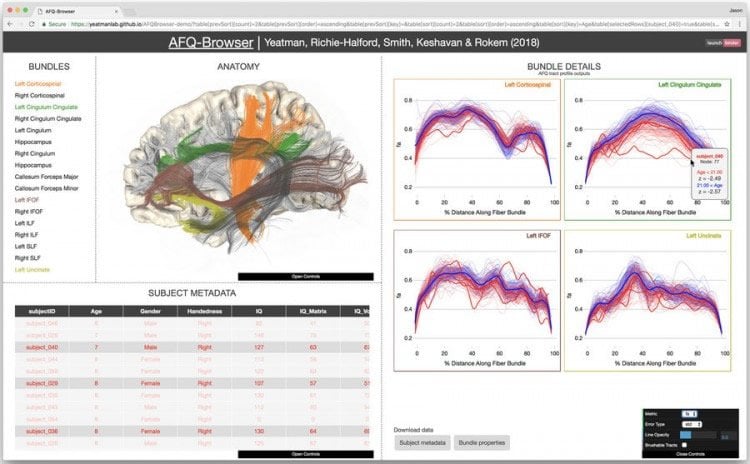Summary: Researchers have developed an open access browser that allows display, sharing and analysis of MRI data.
Source: University of Washington.
Over the past few years, scientists have faced a problem: They often cannot reproduce the results of experiments done by themselves or their peers.
This “replication crisis” plagues fields from medicine to physics, and likely has many causes. But one is undoubtedly the difficulty of sharing the vast amounts of data collected and analyses performed in so-called “big data” studies. The volume and complexity of the information also can make these scientific endeavors unwieldy when it comes time for researchers to share their data and findings with peers and the public.
Researchers at the University of Washington have developed a set of tools to make one critical area of big data research — that of our central nervous system — easier to share. In a paper published online March 5 in Nature Communications, the UW team describes an open-access browser they developed to display, analyze and share neurological data collected through a type of magnetic resonance imaging study known as diffusion-weighted MRI.
“There has been a lot of talk among researchers about the replication crisis,” said lead author Jason Yeatman. “But we wanted a tool — ready, widely available and easy to use — that would actually help fight the replication crisis.”
Yeatman — who is an assistant professor in the UW Department of Speech & Hearing Sciences and the Institute for Learning & Brain Sciences (I-LABS) — is describing AFQ-Browser. This web browser-based tool, freely available online, is a platform for uploading, visualizing, analyzing and sharing diffusion MRI data in a format that is publicly accessible, improving transparency and data-sharing methods for neurological studies. In addition, since it runs in the web browser, AFQ-Browser is portable — requiring no additional software package or equipment beyond a computer and an internet connection.
“One major barrier to data transparency in neuroscience is that so much data collection, storage and analysis occurs on local computers with special software packages,” said senior author Ariel Rokem, a senior data scientist in the UW eScience Institute. “But using AFQ-Browser, we eliminate those requirements and make uploading, sharing and analyzing diffusion-weighted MRI data a simple, straightforward process.”
Diffusion-weighted MRI measures the movement of fluid in the brain and spinal cord, revealing the structure and function of white-matter tracts. These are the connections of the central nervous system, tissue that are made up primarily of axons that transmit long-range signals between neural circuits. Diffusion MRI research on brain connectivity has fundamentally changed the way neuroscientists understand human brain function: The state, organization and layout of white matter tracts are at the core of cognitive functions such as memory, learning and other capabilities. Data collected using diffusion-weighted MRI can be used to diagnose complex neurological conditions such as multiple sclerosis (MS) and amyotrophic lateral sclerosis (ALS). Researchers also use diffusion-weighted MRI data to study the neurological underpinnings of conditions such as dyslexia and learning disabilities.

“This is a widely-used technique in neuroscience research, and it is particularly amenable to the benefits that can be gleaned from big data, so it became a logical starting point for developing browser-based, open-access tools for the field,” said Yeatman.
The AFQ-Browser — the AFQ stands for Automated Fiber-tract Quantification — can receive diffusion-weighted MRI data and perform tract analysis for each individual subject. The analyses occur via a remote server, again eliminating technical and financial barriers for researchers. The AFQ-Browser also contains interactive tools to display data for multiple subjects — allowing a researcher to easily visualize how white matter tracts might be similar or different among subjects, identify trends in the data and generate hypotheses for future experiments.
Researchers also can insert additional code to analyze the data, as well as save, upload and share data instantly with fellow researchers.
“We wanted this tool to be as generalizable as possible, regardless of research goals,” said Rokem. “In addition, the format is easy for scientists from a variety of backgrounds to use and understand — so that neuroscientists, statisticians and other researchers can collaborate, view data and share methods toward greater reproducibility.”
Source: James Urton – University of Washington
Publisher: Organized by NeuroscienceNews.com.
Image Source: NeuroscienceNews.com image is credited to Jason Yeatman/Ariel Rokem.
Original Research: Open access research in Nature Communications.
doi:10.1038/s41467-018-03297-7
[cbtabs][cbtab title=”MLA”]University of Washington “Democratizing Science: Researchers Make Neuroscience Experiments Easier to Share and Reproduce.” NeuroscienceNews. NeuroscienceNews, 15 March 2018.
<https://neurosciencenews.com/neuroscience-share-experiments-8643/>.[/cbtab][cbtab title=”APA”]University of Washington (2018, March 15). Democratizing Science: Researchers Make Neuroscience Experiments Easier to Share and Reproduce. NeuroscienceNews. Retrieved March 15, 2018 from https://neurosciencenews.com/neuroscience-share-experiments-8643/[/cbtab][cbtab title=”Chicago”]University of Washington “Democratizing Science: Researchers Make Neuroscience Experiments Easier to Share and Reproduce.” https://neurosciencenews.com/neuroscience-share-experiments-8643/ (accessed March 15, 2018).[/cbtab][/cbtabs]
Abstract
A browser-based tool for visualization and analysis of diffusion MRI data
Human neuroscience research faces several challenges with regards to reproducibility. While scientists are generally aware that data sharing is important, it is not always clear how to share data in a manner that allows other labs to understand and reproduce published findings. Here we report a new open source tool, AFQ-Browser, that builds an interactive website as a companion to a diffusion MRI study. Because AFQ-Browser is portable—it runs in any web-browser—it can facilitate transparency and data sharing. Moreover, by leveraging new web-visualization technologies to create linked views between different dimensions of the dataset (anatomy, diffusion metrics, subject metadata), AFQ-Browser facilitates exploratory data analysis, fueling new discoveries based on previously published datasets. In an era where Big Data is playing an increasingly prominent role in scientific discovery, so will browser-based tools for exploring high-dimensional datasets, communicating scientific discoveries, aggregating data across labs, and publishing data alongside manuscripts.






